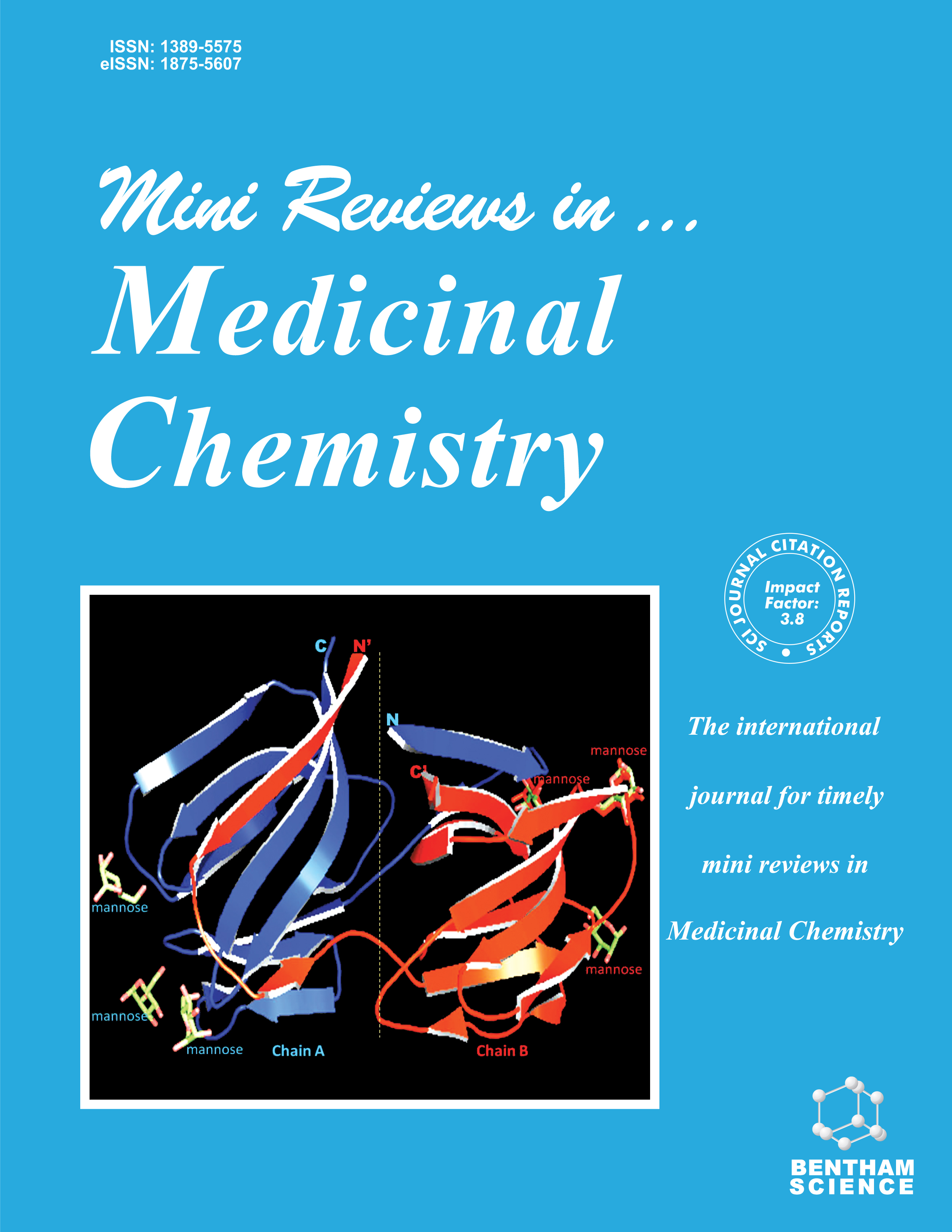- Home
- A-Z Publications
- Mini Reviews in Medicinal Chemistry
- Previous Issues
- Volume 19, Issue 12, 2019
Mini Reviews in Medicinal Chemistry - Volume 19, Issue 12, 2019
Volume 19, Issue 12, 2019
-
-
Correlation between in vitro and in vivo Data of Radiolabeled Peptide for Tumor Targeting
More LessAuthors: Soghra Farzipour and Seyed J. HosseinimehrTumor-targeting peptides have been generally developed for the overexpression of tumor specific receptors in cancer cells. The use of specific radiolabeled peptide allows tumor visualization by single photon emission computed tomography (SPECT) and positron emission tomography (PET) tools. The high affinity and specific binding of radiolabeled peptide are focusing on tumoral receptors. The character of the peptide itself Read More
-
-
-
Liposomes in Active, Passive and Acoustically-Triggered Drug Delivery
More LessAuthors: Sara A. Basha, Najla Salkho, Sarah Dalibalta and Ghaleb Adnan HusseiniCancer has become one of the most deadly noncommunicable diseases globally. Several modalities used to treat cancer patients exist today yet many have failed to prove high efficacy with low side effects. The most common example of such modalities is the use of chemotherapeutic drugs to treat cancerous cells and deter their uncontrolled proliferation. In addition to the destruction of cancerous tissues, chemotherapy des Read More
-
-
-
Some Possibilities to Study New Prophylactics against Nerve Agents
More LessNerve agents belong to the most dangerous chemical warfare agents and can be/were misused by terrorists. Effective prophylaxis and treatment is necessary to diminish their effect. General principles of prophylaxis are summarized (protection against acetylcholinesterase inhibition, detoxification, treatment “in advance” and use of different drugs). They are based on the knowledge of mechanism of action of nerve a Read More
-
-
-
Brain-eating Amoebae Infection: Challenges and Opportunities in Chemotherapy
More LessAuthors: Mohammad R. Mungroo, Ayaz Anwar, Naveed Ahmed Khan and Ruqaiyyah SiddiquiPathogenic free-living amoeba are known to cause a devastating infection of the central nervous system and are often referred to as “brain-eating amoebae”. The mortality rate of more than 90% and free-living nature of these amoebae is a cause for concern. It is distressing that the mortality rate has remained the same over the past few decades, highlighting the lack of interest by the pharmaceutical industry. With the threat Read More
-
-
-
Bisphosphonates and Cancer: A Relationship Beyond the Antiresorptive Effects
More LessAuthors: Sonia Teixeira, Luis Branco, Maria H. Fernandes and João Costa-RodriguesBisphosphonates (BPs) are stable analogues of the Inorganic Pyrophosphate (PPi), an endogenous regulator of bone mineralization, which can resist the hydrolysis in the gastrointestinal tract. Their conformation allows targeting the bone as a result of their three-dimensional structure, which makes them primary agents against osteoclast-mediated bone loss. They are used in many bone pathological conditions, like bon Read More
-
-
-
Synthesis and Biological Activity of 2-Amino- and 2-aryl (Heteryl) Substituted 1,3-Benzothiazin-4-ones
More LessAuthors: Emiliya V. Nosova, Galina N. Lipunova, Valery N. Charushin and Oleg N. ChupakhinTuberculosis (TB) takes the second place among the reasons for mortality from infectious diseases. For this reason, the problem of tuberculosis treatment requires urgent attention all over the world. Some 2-amino substituted 1,3-benzothiazin-4-ones (2-amino-1,3-BTZs) represent a promising new class of antitubercular agents. Other 1,3-benzothiazin-4-one derivatives, mostly 2-aryl and 2- (pyridin-2-yl) ones, are attr Read More
-
-
-
Pharmacophores Modeling in Terms of Prediction of Theoretical Physicochemical Properties and Verification by EXPERIMENTAL correlations of Carbacylamidophosphates (CAPh) and Sulfanylamidophosphates (SAPh) Tested as New Carbonic Anhydrase Inhibitors
More LessBackground: The function of Carbonic anhydrase is to facilitate the physiological process i.e. interconversion of CO2 to HCO3 - by hydration. Carbonic anhydrase enzyme plays a vital role in different physiological processes to regulate pH as well as regulate the inner environment of CO2 and secretion of electrolytes. Methods: Six representatives of amidophosphate derivatives (L1-L6) were synthesized and evaluated for th Read More
-
Volumes & issues
-
Volume 25 (2025)
-
Volume 24 (2024)
-
Volume 23 (2023)
-
Volume 22 (2022)
-
Volume 21 (2021)
-
Volume 20 (2020)
-
Volume 19 (2019)
-
Volume 18 (2018)
-
Volume 17 (2017)
-
Volume 16 (2016)
-
Volume 15 (2015)
-
Volume 14 (2014)
-
Volume 13 (2013)
-
Volume 12 (2012)
-
Volume 11 (2011)
-
Volume 10 (2010)
-
Volume 9 (2009)
-
Volume 8 (2008)
-
Volume 7 (2007)
-
Volume 6 (2006)
-
Volume 5 (2005)
-
Volume 4 (2004)
-
Volume 3 (2003)
-
Volume 2 (2002)
-
Volume 1 (2001)
Most Read This Month
Article
content/journals/mrmc
Journal
10
5
false
en


